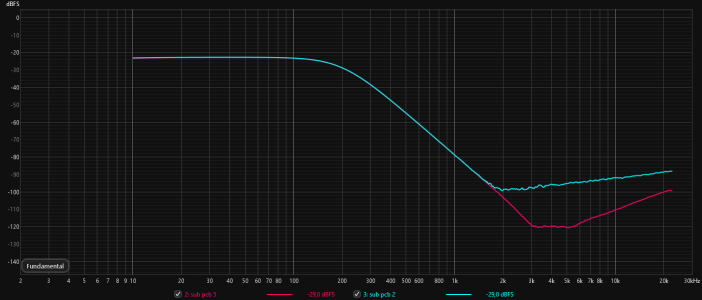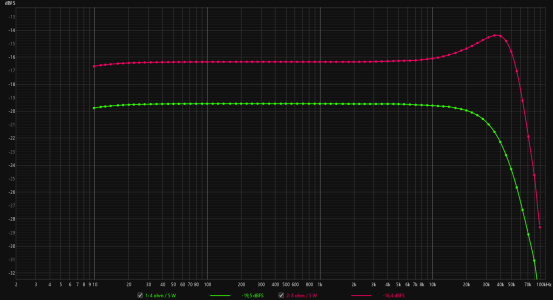You are using an out of date browser. It may not display this or other websites correctly.
You should upgrade or use an alternative browser.
You should upgrade or use an alternative browser.
My WiiM Amp tests, chapter 2
- Thread starter onlyoneme
- Start date
IMO it looks fine, but someone else might confirm or deny it. @harkpabst ?And is this good, bad or indifferent?
@onlyoneme,
Are LPF and HPF both -18db/oct?
And was the cause of the noise a steep slope?
Thank you so much.
Filter steepness is definitely different, telling from your own measurements. With the current firmware it appears to be a 4th order Linkwitz-Riley filter now (which is much more common and most probably favourable over an 8th order filter).
Since my replacement amp was delivered just yesterday (PCB_version 5) I didn't spend time for measurements, yet. But I will at some point I'm the near future. I didn't measure anything on the previous unit (PCB_version 4).
Once again, great work! Thanks a lot!
PS:
The slopes look good to me. The slight rise above 5 kHz is absolutely negligible. It's still down by ~80 dB at 20 kHz and no sub will play that high, anyway.
Since my replacement amp was delivered just yesterday (PCB_version 5) I didn't spend time for measurements, yet. But I will at some point I'm the near future. I didn't measure anything on the previous unit (PCB_version 4).
Once again, great work! Thanks a lot!
PS:
The slopes look good to me. The slight rise above 5 kHz is absolutely negligible. It's still down by ~80 dB at 20 kHz and no sub will play that high, anyway.
Last edited:
It's rather -24 dB/oct I think.Are LPF and HPF both -18db/oct?
I can't see well with presbyopiaIt's rather -24 dB/oct I think.
Glasses are my best friends tooI can't see well with presbyopia
Hi all, first post here I have been looking at PCB versions mentioned on here and the various issues people are having. I got my amp on new year's eve from Amazon UK. It has PCB version 4 and there is an obvious high pitch continual whine from the unit itself but so far it only seems to be audible to me with my ear close to the unit. I haven't experienced any other unwanted sounds so far. It would be amazing to hear of any known differences between PCB 5 and version 4. These tests are really interesting so thanks for your efforts.
I cannot help because I have no access to pcb 4 unit.It would be amazing to hear of any known differences between PCB 5 and version 4.
Completely understand and I am grateful for what you have shared. I just wanted to comment for others who have PCB 4 in case they are curious about any known issues or have any other input to this. For info my RCA inputs are reversed like your PCB 5 version but I have no class ll mark.I cannot help because I have no access to pcb 4 unit.
I would open a ticket and return/exchange the Amp. Otherwise you might regret that in the future even though there might be nothing else wrong with your device.there is an obvious high pitch continual whine from the unit itself
@onlyoneme, I’m glad to see you posting measurements. I haven’t seen you posting here in a while. I had ver 2 but return it and purchase again and got ver 5. No hum unlike the first one.
in the case of using this type of amplifier it is still interesting to observe the effective impedance curve of the speakers concerned.....A new unit is with me. Because new device is too cold to be powered, I can focus on external differences. Both units are almost undistinguishable.
One difference is reversed channels on RCA inputs. Second one is a class II power supply mark printed on the bottom.
I've seen units with reversed RCA plugs in some recent YouTube movies, so this change was probably applied in the meantime.
There are also subtle differences between outside boxes, like the mentioned class II mark. Another one are black and white icons of the music services vs colorful ones for the box of old unit.
First things first, as the full set of measurements and tests takes a lot of time, I will verify known issues at the very beginning.
PSU noise - absent, it's (almost) deadly silent. I can hear something only when my ear touches the chassis directly. Well, I know it could be pretty risky idea...
PCB_version - 5.
HF switching signal on sub out - absent.
Low frequencies / multitone bad performance - seems to be greatly improved in my quick and dirty measurements. I will provide more details tomorrow.
SMPTE, 5W:
View attachment 4658
Multitone, 5W:
View attachment 4659
Differences are huge.
Another example of improvement, this time for THD+N vs level at 100 Hz, 4 ohm load as before:
View attachment 4674
An old unit starts to distort much earlier.
THD+N vs level measurements at different frequencies finally look like for other TPA3255 implementations, 4 ohm:
View attachment 4680
Below the same measurements but for V1 unit:
View attachment 4681
Yet another comparison vs old unit, for multitone measurement at different load levels:
View attachment 4683
THD at 5W/4ohm load, related to frequency, for both units:
View attachment 4724
Surprisingly slightly worse performance for higher frequencies in case of the new model.
It can be also seen for lower 1W load:
View attachment 4725
Measurements - optical in to speakers out
All tests here were made with an external LPF. More details: https://forum.wiimhome.com/threads/my-wiim-amp-tests.1873/
Although the new revision is a clear improvement over an old one, the most basic SINAD measurement for 1 kHz sine signal will not reflect it at all in case of 4 ohm load.
4 ohm / 5 W, an old unit:
View attachment 5035
And the new one:
View attachment 5036
For 8 ohm load there is a measurable improvement.
8 ohm / 5 W, an old unit:
View attachment 5037
And the new one:
View attachment 5038
Nothing has changed in case of the load dependency:
View attachment 5039
Crosstalk, left to right and right to left, 4 ohm / 5 W:
View attachment 5040
THD+N vs output voltage, for 4 ohm and 8 ohm load:
View attachment 5041
And details for different frequencies, 4 ohm:
View attachment 5042
and 8 ohm:
View attachment 5043
THD vs frequency, for 4 ohm and 8 ohm:
View attachment 5044
Stay tuned.
the situations when going up in frequencies are so variable...
Attachments
Last edited:
This is typical of entry level Class D. However, PFFB will be integrated into new amplifiers by Aiyima and Fosi Audio. I hope that WiiM incorporates PFFB into the next version of the Amp to eliminate load dependency.in the case of using this type of amplifier it is still interesting to observe the effective impedance curve of the speakers concerned.....
the situations when going up in frequencies are so variable...

The rise into 8 ohms load is less than 2 dB at 20 kHz (edit: closer to 1 dB, I think). Not nice for sure, but also not reason for too many concerns.in the case of using this type of amplifier it is still interesting to observe the effective impedance curve of the speakers concerned.....
the situations when going up in frequencies are so variable...

Implementing the TPA3255 with post-filter feedback would have improved on that noticeably.
It's important to understand that these measurements are taken with a purely resistive load. Just from looking at this one graph you cannot say for sure what's going to happen with inductive (or even capacitive) load.
In other words: Just because a loudspeaker is sold as being nominally 8 ohms or even because the impedance trace shows an absolute value of 8 ohms at high frequencies doesn't necessarily mean the rise in SPL will be as seen in this graph.
Last edited:
Similar threads
- Replies
- 1
- Views
- 343
- Replies
- 12
- Views
- 871
- Replies
- 194
- Views
- 16K
- Replies
- 391
- Views
- 41K



